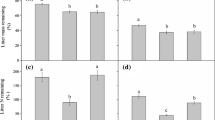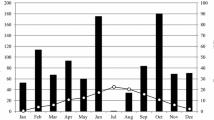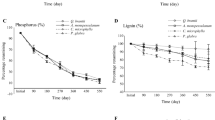Abstract
Background
In boreal peatlands, climate warming and associated soil drying facilitate the growth of vascular plants at the cost of moss species, resulting in an alteration of species dominance in plant communities. However, how altered dominant species and evenness affect litter mixture decomposition is still unclear in these ecosystems.
Methods
We collected fresh litter from Larix gmelinii (tree), Betula fruticosa (shrub), Eriophorum vaginatum (sedge), and Sphagnum magellanicum (moss), and determined mass loss and nitrogen (N) release of four-species mixtures with varying dominant species and evenness at 10 and 20 oC during 360-day decomposition.
Results
Irrespective of the incubation temperature, B. fruticosa-dominated litter mixtures had greatest mass loss and N release throughout decomposition, while S. magellanicum-dominated litter mixtures had lowest values. Moreover, mass loss and N release of B. fruticosa-dominated litter mixtures decreased with elevating evenness after 360 days of decomposition, but the opposite trends were observed for litter mixtures dominated by the other three species. Increasing incubation temperature facilitated decomposition of all litter mixtures, with the lowest magnitude for S. magellanicum-dominated mixtures. Non-additive effects, especially positive effects, on mass loss and N release were common, which played a key role in enhancing the influences of dominant species and evenness on litter mixture decomposition. Moreover, the incidence of positive non-additive effects on mass loss decreased at 20 oC as litter decomposition proceeded.
Conclusions
Warming-induced increased dominance of vascular plants, especially shrubs, will amplify the warming effect on litter decomposition and N availability in boreal peatlands, thus generating positive feedback to climate warming.






Similar content being viewed by others
References
Barantal S, Roy J, Fromin N, Schimann H, Hattenschwiler S (2011) Long-term presence of tree species but not chemical diversity affect litter mixture effects on decomposition in a neotropical rainforest. Oecologia 167:241–252
Berg B, Staaf H (1980) Decomposition rate and chemical changes of Scots pine needle litter. II Influence of Chemical Composition. Ecol Bull 32:373–390
Bonanomi G, Capodilupo M, Incerti G, Mazzoleni S (2014) Nitrogen transfer in litter mixture enhances decomposition rate, temperature sensitivity, and C quality changes. Plant Soil 381:307–321
Bonanomi G, Incerti G, Antignani V, Capodilupo M, Mazzoleni S (2010) Decomposition and nutrient dynamics in mixed litter of Mediterranean species. Plant Soil 331:481–496
Bradford MA, Maynard DS, Crowther TW, Frankson PT, Mohan JE, Steinrueck C, Veen CGF, King JR, Warren II RJ (2021) Belowground community turnover accelerates the decomposition of standing dead wood. Ecology 00:e03484. https://doi.org/10.1002/ecy.3484
Breeuwer A, Heijmans M, Robroek BJM, Limpens J, Berendse F (2008) The effect of increased temperature and nitrogen deposition on decomposition in bogs. Oikos 117:1258–1268
Bridgham SD, Megonigal JP, Keller JK, Bliss NB, Trettin C (2006) The carbon balance of North American wetlands. Wetlands 26:889–916
Buttler A, Robroek BJM, Laggoun-Defarge F, Jassey VEJ, Pochelon C, Bernard G, Delarue F, Gogo S, Mariotte P, Mitchell EAD, Bragazza L (2015) Experimental warming interacts with soil moisture to discriminate plant responses in an ombrotrophic peatland. J Veg Sci 26:964–974
Cornelissen JHC, Van Bodegom PM, Aerts R, Callaghan TV, Van Logtestijn RSP, Alatalo J, Stuart Chapin F, Gerdol R, Gudmundsson J, Gwynnjones D (2007) Global negative vegetation feedback to climate warming responses of leaf litter decomposition rates in cold biomes. Ecol Lett 10:619–627
De Deyn GB, Cornelissen JHC, Bardgett RD (2008) Plant functional traits and soil carbon sequestration in contrasting biomes. Ecol Lett 11:516–531
Dickson TL, Wilsey BJ (2009) Biodiversity and tallgrass prairie decomposition: the relative importance of species identity, evenness, richness, and micro-topography. Plant Ecol 201:639–649
Dieleman CM, Branfireun BA, McLaughlin JW, Lindo Z (2015) Climate change drives a shift in peatland ecosystem plant community: Implications for ecosystem function and stability. Global Change Biol 21:388–395
Domisch T, Finér L, Laine J, Laiho R (2006) Decomposition and nitrogen dynamics of litter in peat soils from two climatic regions under different temperature regimes. Eur J Soil Biol 42:74–81
Dorrepaal E, Cornelissen JHC, Aerts R, Wallen B, Van Logtestijn RSP (2005) Are growth forms consistent predictors of leaf litter quality and decomposability across peatlands along a latitudinal gradient? J Ecol 93:817–828
Favreau M, Pellerin S, Poulin M (2019) Tree encroachment induces biotic differentiation in Sphagnum-dominated bogs. Wetlands 39:841–852
Freeman C, Ostle N, Kang H (2001) An enzymic ‘latch’ on a global carbon store - A shortage of oxygen locks up carbon in peatlands by restraining a single enzyme. Nature 409:149–149
Fudyma JD, Lyon J, Aminitabrizi R, Gieschen H, Tfaily MM (2019) Untargeted metabolomic profiling of Sphagnum fallax reveals novel antimicrobial metabolites. Plant Direct 3:1–17
García-Palacios P, Shaw EA, Wall DH, Hättenschwiler S (2017) Contrasting mass-ratio vs. niche complementarity effects on litter C and N loss during decomposition along a regional climatic gradient. J Ecol 105:968–978
Garnier E, Cortez J, Billes G, Navas ML, Roumet C, Debussche M, Laurent G, Blanchard A, Aubry D, Bellmann A, Neill C, Toussaint JP (2004) Plant functional markers capture ecosystem properties during secondary succession. Ecology 85:2630–2637
Golovatskaya EA, Dyukarev EA (2008) Carbon budget of oligotrophic mire sites in the Southern Taiga of Western Siberia. Plant Soil 315:19–34
Gorham E (1991) Northern peatlands: role in the carbon cycle and probable responses to climatic warming. Ecol Appl 1:182–195
Grime J (1998) Benefits of plant diversity to ecosystems: immediate, filter and founder effects. J Ecol 86:902–910
Hajek T, Ballance S, Limpens J, Zijlstra M, Verhoeven JTA (2011) Cell-wall polysaccharides play an important role in decay resistance of Sphagnum and actively depressed decomposition in vitro. Biogeochemistry 103:45–57
Handa IT, Aerts R, Berendse F, Berg MP, Bruder A, Butenschoen O, Chauvet E, Gessner MO, Jabiol J, Makkonen M, McKie BG, Malmqvist B, Peeters E, Scheu S, Schmid B, van Ruijven J, Vos VCA, Hattenschwiler S (2014) Consequences of biodiversity loss for litter decomposition across biomes. Nature 509:218–221
Hobbie SE, Gough L (2004) Litter decomposition in moist acidic and non-acidic tundra with different glacial histories. Oecologia 140:113–124
Hoorens B, Aerts R, Stroetenga M (2002) Litter quality and interactive effects in litter mixtures: more negative interactions under elevated CO2? J Ecol 90:1009–1016
Hoorens B, Stroetenga M, Aerts R (2009) Litter mixture interactions at the level of plant functional types are additive. Ecosystems 13:90–98
IPCC (2018) Summary for Policymakers. In Masson-Delmotte V et al. (eds.), Global Warming of 1.5°C. An IPCC Special Report on the impacts of global warming of 1.5°C above pre-industrial levels and related global greenhouse gas emission pathways, in the context of strengthening the global response to the threat of climate change, sustainable development, and efforts to eradicate poverty. Geneva: World Meteorological Organization
Jin HJ, Yu QH, Guo DX, He RX, Yu SP, Sun GY, Li YW (2007) Degradation of permafrost in the Xing’an Mountains, Northeast China. Permafrost Periglac 18:245–258
King RF, Dromph KM, Bardgett RD (2002) Changes in species evenness of litter have no effect on decomposition processes. Soil Biol Bioch 34:1959–1963
Kirwan L, LÜScher A, SebastiÀ MT, Finn JA, Collins RP, Porqueddu C, Helgadottir A, Baadshaug OH, Brophy C, Coran C, DalmannsdÓTtir S, Delgado I, Elgersma A, Fothergill M, Frankow-Lindberg BE, Golinski P, Grieu P, Gustavsson AM, HÖGlind M, Huguenin-Elie O, Iliadis C, JØRgensen M, Kadziuliene Z, Karyotis T, Lunnan T, Malengier M, Maltoni S, Meyer V, Nyfeler D, Nykanen-Kurki P, Parente J, Smit HJ, Thumm U, Connolly J (2007) Evenness drives consistent diversity effects in intensive grassland systems across 28 European sites. J Ecol 95:530–539
Laliberté E, Legendre P (2010) A distance-based framework for measuring functional diversity from multiple traits. Ecology 91:299–305
Laliberté E, Legendre P, Shipley B (2014) FD: measuring functional diversity from multiple traits, and other tools for functional ecology. R package version 1:0–12. https://cran.r-project.org/web/packages/FD/index.html.
Li D, Peng S, Chen B (2013) The effects of leaf litter evenness on decomposition depend on which plant functional group is dominant. Plant Soil 365:255–266
Lin GG, Mao R, Zhao L, Zeng DH (2013) Litter decomposition of a pine plantation is affected by species evenness and soil nitrogen availability. Plant Soil 373:649–657
Lummer D, Scheu S, Butenschoen O (2012) Connecting litter quality, microbial community and nitrogen transfer mechanisms in decomposing litter mixtures. Oikos 121:1649–1655
Malhotra A, Brice DJ, Childs J, Graham JD, Hobbie EA, Vander Stel H, Feron SC, Hanson PJ, Iversen CM (2020) Peatland warming strongly increases fine-root growth. Proc Natl Acad Sci USA 117:17627–17634
Mao R, Zhang X, Song C, Wang X, Finnegan PM (2018) Plant functional group controls litter decomposition rate and its temperature sensitivity: An incubation experiment on litters from a boreal peatland in northeast China. Sci Total Environ 626:678–683
Moore TR, Bubier JL, Bledzki L (2007) Litter decomposition in temperate peatland ecosystems: the effect of substrate and site. Ecosystems 10:949–963
Palozzi JE, Lindo Z (2017) Pure and mixed litters of Sphagnum and Carex exhibit a home-field advantage in Boreal peatlands. Soil Biol Biochem 115:161–168
Plazas-Jiménez D, Cianciaruso MV (2021) Leaf decomposition depends on nutritional trait values but increasing trait variability does not always increase decomposition efficiency. Oikos 130:1171–1179
Santonja M, Rodríguez-Pérez H, Le Bris N, Piscart C (2020) Leaf nutrients and macroinvertebrates control litter mixing effects on decomposition in temperate streams. Ecosystems 23:400–416
Schellekens J, Bindler R, Martínez-Cortizas A, McClymont EL, Abbott GD, Biester H, Pontevedra-Pombal X, Buurman P (2015) Preferential degradation of polyphenols from Sphagnum – 4-Isopropenylphenol as a proxy for past hydrological conditions in Sphagnum-dominated peat. Geochim Cosmochim Ac 150:74–89
Smith DL, Johnson L (2004) Vegetation-mediated changes in microclimate reduce soil respiration as woodlands expand into grasslands. Ecology 85:3348–3361
Smith MD, Knapp AK (2003) Dominant species maintain ecosystem function with non-random species loss. Ecol Lett 6:509–517
Thompson DK, Simpson BN, Beaudoin A (2016) Using forest structure to predict the distribution of treed boreal peatlands in Canada. Forest Ecol Manag 372:19–27
Treat CC, Kleinen T, Broothaerts N, Dalton AS, Dommain R, Douglas TA, Drexler JZ, Finkelstein SA, Grosse G, Hope G, Hutchings J, Jones MC, Kuhry P, Lacourse T, Lahteenoja O, Loisel J, Notebaert B, Payne RJ, Peteet DM, Sannel ABK, Stelling JM, Strauss J, Swindles GT, Talbot J, Tarnocai C, Verstraeten G, Williams CJ, Xia Z, Yu Z, Valiranta M, Hattestrand M, Alexanderson H, Brovkin V (2019) Widespread global peatland establishment and persistence over the last 130,000 y. Proc Natl Acad Sci USA 116:4822–4827
Wang X, Song C, Sun X, Wang J, Zhang X, Mao R (2013) Soil carbon and nitrogen across wetland types in discontinuous permafrost zone of the Xiao Xing’an Mountains, northeastern China. CATENA 101:31–37
Ward SE, Ostle NJ, McNamara NP, Bardgett RD (2010) Litter evenness influences short-term peatland decomposition processes. Oecologia 164:511–520
Ward SE, Ostle NJ, Oakley S, Quirk H, Henrys PA, Bardgett RD (2013) Warming effects on greenhouse gas fluxes in peatlands are modulated by vegetation composition. Ecol Lett 16:1285–1293
Ward SE, Orwin KH, Ostle NJ, Briones MJI, Thomson BC, Griffiths RI, Oakley S, Quirk H, Bardgett RD (2015) Vegetation exerts a greater control on litter decomposition than climate warming in peatlands. Ecology 96:113–123
Wardle DA, Bonner KI, Nicholson KS (1997) Biodiversity and plant litter: experimental evidence which does not support the view that enhanced species richness improves ecosystem function. Oikos 79:247–258
Xing W, Bao K, Gallego-Sala AV, Charman DJ, Zhang Z, Gao C, Lu X, Wang G (2015) Climate controls on carbon accumulation in peatlands of Northeast China. Quaternary Sci Rev 115:78–88
Yu Z, Beilman DW, Frolking S, Macdonald GM, Roulet NT, Camill P, Charman DJ (2011) Peatlands and their role in the global carbon cycle. Eos Trans AGU 92:97–98
Zhang XH, Sun XX, Mao R (2017) Effects of litter evenness, nitrogen enrichment and temperature on short-term litter decomposition in freshwater marshes of northeast China. Wetlands 37:145–152
Zhang X, Wang X, Finnegan PM, Tan W, Mao R (2019) Effects of litter mixtures on aerobic decomposition rate and its temperature sensitivity in a boreal peatland. Geoderma 354:113890
Zhang XH, Wang L, Jiang W, Mao R (2020a) Functional identity and functional diversity co-regulate litter mixture decomposition and nitrogen release in boreal riparian forest ponds. Biogeochemistry 151:99–111
Zhang X, Wang Y, Jiang W, Mao R (2020b) Effect of expanded shrub litter on decomposition of graminoid litter in a temperate freshwater marsh. Plant Soil 451:409–418
Zhou Y, Wang Y, Gao X, Yue H (1996) Temperatures and distribution of permafrost in northeastern China under a warming climate. J Glaciol Geocryol 18:139–147 (In Chinese)
Acknowledgements
This study was financed by the National Natural Science Foundation of China (Nos. 41671091 and 31570479). We are grateful to the editor and the reviewers for their constructive comments on our manuscript.
Author information
Authors and Affiliations
Corresponding author
Additional information
Responsible Editor: Alfonso Escudero.
Publisher's note
Springer Nature remains neutral with regard to jurisdictional claims in published maps and institutional affiliations.
Supplementary Information
Below is the link to the electronic supplementary material.
Rights and permissions
About this article
Cite this article
Zhang, X., Zhang, Y., Jiang, S. et al. Dominant species and evenness level co-regulate litter mixture decomposition in a boreal peatland. Plant Soil 474, 423–436 (2022). https://doi.org/10.1007/s11104-022-05346-z
Received:
Accepted:
Published:
Issue Date:
DOI: https://doi.org/10.1007/s11104-022-05346-z




